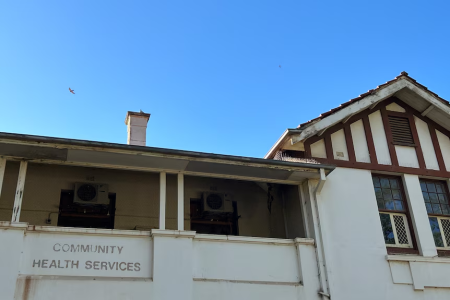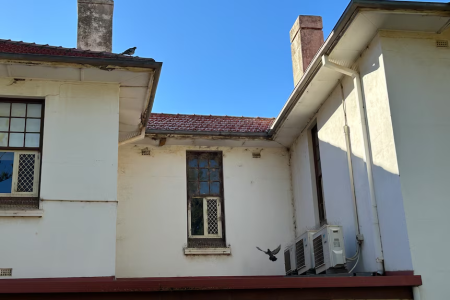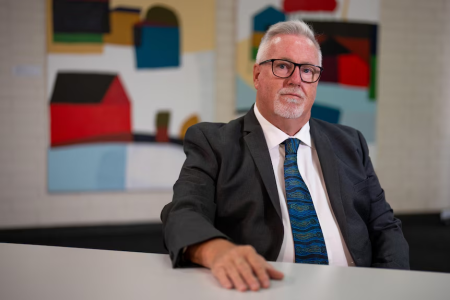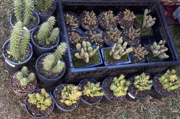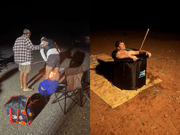Pigeon infestation forces SA Health staff out of Port Pirie office building
By
ABC News
- Replies 0
About 100 SA Health employees have been moved from a building in Port Pirie due to a pigeon infestation.
SA Health said the workers were moved from the Port Pirie Community Health administration building last Wednesday, and the building was temporarily closed.
Yorke and Northern Local Health Network CEO Roger Kirchner said staff notified them of the problem, which was affecting multiple areas on the building's top floor.
'The tests have come back and certainly show … bacteria,' he said.
'We've now engaged another group of independent testers. They were on site late last week to actually give us further tests on the first storey.
'We've actually asked them to do tests on the ground floor as well.
'We will have to look at how bad that is, whether or not we believe it is possible to stop them gaining access and if not we'll have to come up with a longer-term plan of what we're going to do with that building and the staff.'
Mr Kirchner said the health network was 'hoping' the ground floor would be able to be used again 'in the short-term future'.
'We've constantly tried to eradicate the birds from the building but it doesn't seem to matter how many spikes, bits and pieces you do,' he said.
Problem for local businesses
Local bakery owner Emily Nguyen said the pigeons were more than an eyesore for her business, having taken a financial toll.
'They [have broken] my solar panels and made them very dirty,' she said.
'[It cost] $30,000 for new ones, $700 to cover [the roof] and clean-up was $300.
'People come in here, and you see a lot [of pigeons outside] ... and it doesn't look nice.
Ms Nguyen said there were often lots of pigeons in the early morning and again in the afternoon.
'They make things very dirty and they're not good for the businesses,' she said.
'I just want the council to clean it up.'
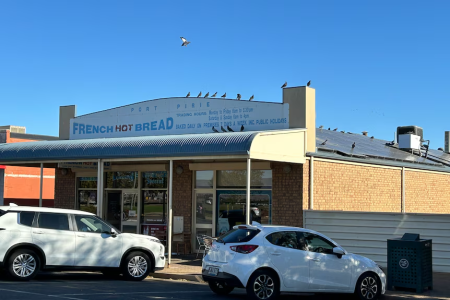
'Nothing seems to stop them'
Port Pirie Regional Council Mayor Leon Stephens said the problem had been brought to council about three years ago.
He said over the last two years about 22,000 pigeons had been culled in town.
'Every time you put a spike on a curb or a peak of a building I think the pigeons use them as back-scratchers,' Mr Stephens said.
'Nothing seems to stop them, unfortunately.'
Mr Stephens said the silos were a major attraction for the pest in any town due to being a source of food.
He said the state government should help by giving money to councils with silos in their towns to go towards pigeon culling efforts.
'Every time I go down to an LGA meeting with the rest of the mayors there's the same issue happening throughout South Australia and it's far too big for a little council to handle,' he said.
In a statement, a state government spokesperson said wild pigeons were the responsibility of landowners.
'As pigeons are not declared under legislation or regulation for control in South Australia the state government does not actively facilitate the management of this species,' they said.
'The most effective management strategies for limiting the abundance of this species on buildings and structures include actions that obstruct or prevent access to roosting — perches protected from the elements — and breeding areas.
'The SA Health website contains some useful information about feral pigeons, including their impact on human health and techniques that can be used to reduce or remove the population.'
Written by Viki Ntafillis, ABC News.
SA Health said the workers were moved from the Port Pirie Community Health administration building last Wednesday, and the building was temporarily closed.
Yorke and Northern Local Health Network CEO Roger Kirchner said staff notified them of the problem, which was affecting multiple areas on the building's top floor.
'The tests have come back and certainly show … bacteria,' he said.
'We've now engaged another group of independent testers. They were on site late last week to actually give us further tests on the first storey.
'We've actually asked them to do tests on the ground floor as well.
'We will have to look at how bad that is, whether or not we believe it is possible to stop them gaining access and if not we'll have to come up with a longer-term plan of what we're going to do with that building and the staff.'
Mr Kirchner said the health network was 'hoping' the ground floor would be able to be used again 'in the short-term future'.
'We've constantly tried to eradicate the birds from the building but it doesn't seem to matter how many spikes, bits and pieces you do,' he said.
Problem for local businesses
Local bakery owner Emily Nguyen said the pigeons were more than an eyesore for her business, having taken a financial toll.
'They [have broken] my solar panels and made them very dirty,' she said.
'[It cost] $30,000 for new ones, $700 to cover [the roof] and clean-up was $300.
'People come in here, and you see a lot [of pigeons outside] ... and it doesn't look nice.
Ms Nguyen said there were often lots of pigeons in the early morning and again in the afternoon.
'They make things very dirty and they're not good for the businesses,' she said.
'I just want the council to clean it up.'

Pigeons perched all over the roof and solar panels of Emily Nguyen's business. (ABC North and West SA: Viki Ntafillis)
'Nothing seems to stop them'
Port Pirie Regional Council Mayor Leon Stephens said the problem had been brought to council about three years ago.
He said over the last two years about 22,000 pigeons had been culled in town.
'Every time you put a spike on a curb or a peak of a building I think the pigeons use them as back-scratchers,' Mr Stephens said.
'Nothing seems to stop them, unfortunately.'
Mr Stephens said the silos were a major attraction for the pest in any town due to being a source of food.
He said the state government should help by giving money to councils with silos in their towns to go towards pigeon culling efforts.
'Every time I go down to an LGA meeting with the rest of the mayors there's the same issue happening throughout South Australia and it's far too big for a little council to handle,' he said.
In a statement, a state government spokesperson said wild pigeons were the responsibility of landowners.
'As pigeons are not declared under legislation or regulation for control in South Australia the state government does not actively facilitate the management of this species,' they said.
'The most effective management strategies for limiting the abundance of this species on buildings and structures include actions that obstruct or prevent access to roosting — perches protected from the elements — and breeding areas.
'The SA Health website contains some useful information about feral pigeons, including their impact on human health and techniques that can be used to reduce or remove the population.'
Written by Viki Ntafillis, ABC News.

